

|
 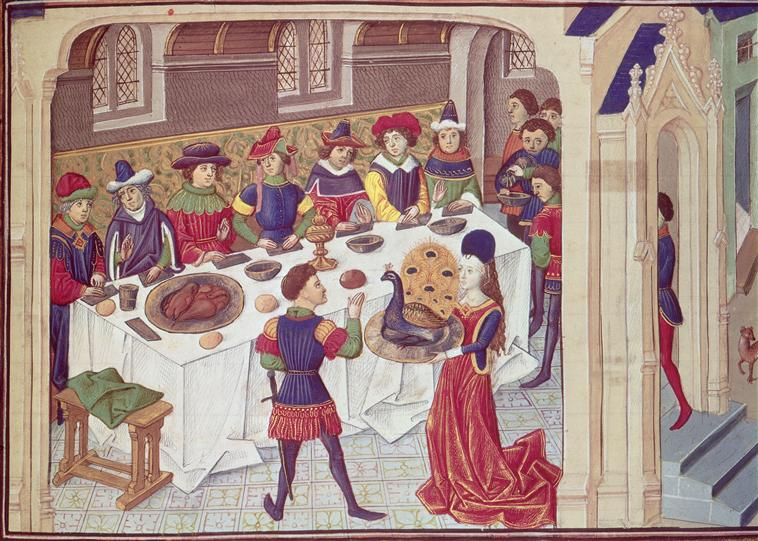 Fancy putting on an old-style feast? You’ll find thousands and thousands of individual dishes on these pages, but, to re-discover the true taste of Old England, more important than the dishes themselves is, perhaps, the way they used to be served. A magnificent style that we’ve now forgotten… TO BEGIN… You’ll need some Whets– nibbles to ‘whet’ the appetite. Perhaps Chewitts, Frians, Oyster Chewitts, Kickshaws, Peasecods or some Ryschewys, or why not go all out for some Farts? OLD ENGLISH SERVICE English Table Service is taken to mean the old-fashioned practice of giving each diner an empty plate, and placing every dish on the table, sweet and savoury at the same time, for the diners to help themselves. Where the service is so large that the table simply can’t accommodate it, there would be ‘removes’ where some of the dishes were replaced, so that a grand banquet might be described as having so-many ‘removes’. This old method is described in cookery books from around 1650, and given with a great deal of detail at the end of Moxon 1764. As late as 1844 ‘Punch‘ could joke that “Three removes are better than a dessert”. It is only rarely used now, but partly survives in the English practice of delivering vegetables in a separate dish from meats, for the diners to help themselves and is still customarily followed to some extent at the Christmas Feast. How table service was conducted in England before the 17th Century, or in modest households, has to be mere conjecture. 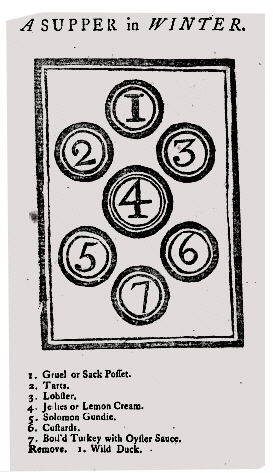 Table layout for a service with one remove From: Moxon 1764 Traditional French Service has each course brought from the kitchen one at a time, and placed in platters on the table for the diners to help themselves, or be served by the waiter. Both these have now been largely replaced by Russian Service, where the food – famously ‘meat-and-two-veg’ – is portioned and carved either in the kitchen or in the restaurant, and then delivered, one ready-made course at a time, to the diner. CENTREPIECES Making up a Cockatrice from the front end of a fowl and the back end of a pig may be going a bit far, but until, it seems, the 1950s, no banquet was complete without some sort of grand show-off centrepiece… 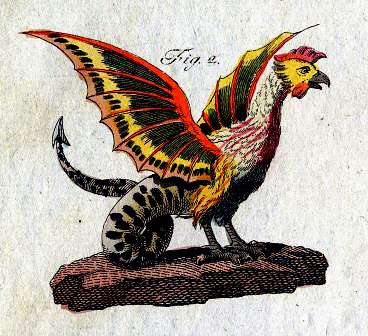 Cockatrice Image: Unknown …which could be the ceremonially paraded-in lump of meat, such as the grand rib of beef or a boar’s head… 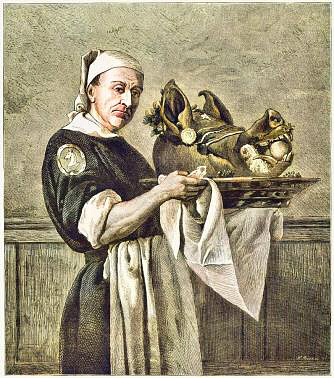 ‘Bringing in the Boar’s Head’ for a Christmas feast. Engraving, English, 1871 … or a Trunk Pie Image: Unknown …or, equally, some fantastically towering desert like a Chesterfield or Nesselrode Pudding, or.. 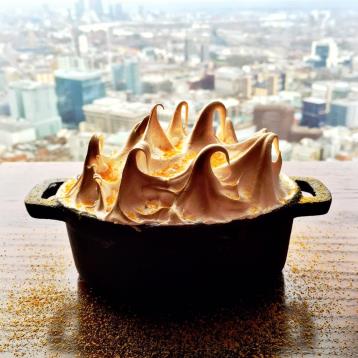 Queen of Puddings Image: Dan Doherty http://www.dan-doherty.co.uk/ AND SOME SUBTELTIES… ‘Subtelties’ are ornamental forms, often of sugar or moulded paste, mainly as table decorations, rather than to be eaten. Known at least since the introduction to ‘The Forme of Cury‘ by the Chief Master-Cook of King Richard II, c1390 (Cury 1390), which has; “to make curious potages & meetes and sotiltees.” while a note from about 1440 in the Collection of Ordinances of the Royal Household has; “A soteltee: Seint jorge on horsebak, and sleynge the dragun.” The 15th Century verse cookery book ‘Liber Cure Cocorum‘ has a receipt for joke worms and the Austin Manuscripts (Austin 1440) records an edible fake earthenware pot under the name ‘Appraylere‘. But, of you want to go all-out, there’s nothing to beat Robert May’s plans from 1660: in his “Triumphs and Trophies in Cookery, to be used at Festival Times, as Twelfth-day, &c;”. He outlines a grand dinner in which a flour-paste ship fires real cannons, a model castle explodes and an edible stag bleeds Claret “being done with admiration to the beholders” and after “the Ladies take egg-shells full of sweet waters and throw them at each other” he then presents two blind-baked pies “where lifting first the lid off one pye, out skip some Frogs, which make the Ladies to skip and shreek; next after the other pye, whence come out the Birds, who by a natural instinct flying in the light, will put out the Candles; so that what with the flying Birds and skipping Frogs, the one above, the other beneath, will cause much delight and pleasure to the whole company.” Such things, he regrets, were “formerly the delight of the Nobility, before good House-keeping had left England”.  |
|
MORE FROM Foods of England... Cookbooks ● Diary ● Index ● Magic Menu ● Random ● Really English? ● Timeline ● Donate ● Royalty ● English Service ● Food Map of England ● Lost Foods ● Accompaniments ● Biscuits ● Breads ● Cakes and Scones ● Cheeses ● Classic Meals ● Curry Dishes ● Dairy ● Drinks ● Egg Dishes ● Fish ● Fruit ● Fruits & Vegetables ● Game & Offal ● Meat & Meat Dishes ● Pastries and Pies ● Pot Meals ● Poultry ● Preserves & Jams ● Puddings & Sweets ● Sauces and Spicery ● Sausages ● Scones ● Soups ● Sweets and Toffee ● About ... ● Bookshop ● Email: [email protected] COPYRIGHT and ALL RIGHTS RESERVED: © Glyn Hughes 2022 BUILT WITH WHIMBERRY |